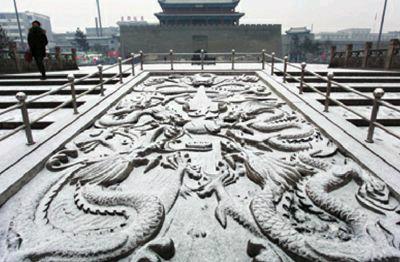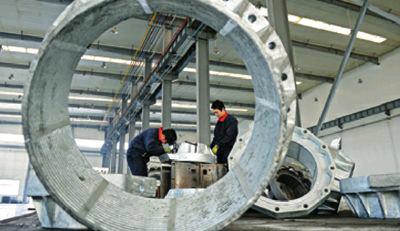First Snow
2015-02-05
Zhangjiakou in Hebei Province sees its first snow in 2015 on January 14.
The snow hit many places in the north of China, including Beijing and Hohhot, capital city of Inner Mongolia Autonomous Region. But the snow in Beijing was very light. The citys meteorological station recorded snowfall of less than 1 mm.
Anti-Graft Priorities
A communique, issued after the fifth plenary session of the Central Commission for Discipline Inspection(CCDI) of the Communist Party of China, which ended on January 14, has put forward seven priorities for 2015, including closer scrutiny of senior officials, an intensification in efforts to track down corrupt fugitives hiding abroad and a tightening of supervision on stateowned enterprises.
The session, which was attended by 125 CCDI members, reviewed and passed a report presented by Wang Qishan, the CCDI chief. President Xi Jinping also addressed the assembled members, which included many senior Chinese leaders, about the countrys efforts to eradicate corruption.
The communique said the campaign required political composure, restraint and patience, but stressed that it was not merely a “whirlwind campaign” and the efforts undertaken should not spur “mass movements” that could potentially disturb or undermine social order.
Real ID Online
China will expand the real-name registration system across more social networks and websites. The Cyberspace Administration of China(CAC) will “comprehensively” promote the management of real identities online, with social networks—including microblogging platforms, forums and instant messaging services—all having to enforce a real-name registration system, CAC official Xu Feng said at a press conference on January 13.
Real names will only be seen by backend administrators and users may still choose a screen name.
Chinese Internet authorities have been pressing for a real identity system since 2011, and new users of WeChat and other instant messaging apps have, since August, been required to provide their real names.
China has more than 275 million users on microblogs with Sina Weibo leading the pack, and 459 million users of mobile instant messaging apps, led by WeChat.
Second Child
Nearly 1 million couples have applied to have a second child since China eased its one-child policy in 2014, allowing couples to have a second child if either parent is an only child.
The number of applications falls close to the estimate of less than 2 million annually by Chinas National Health and Family Planning Commission, said Mao Qunan, a spokesman with the commission, at a press conference on January 12.
Since Chinas family planning policy was eased in a pilot program in east Chinas Zhejiang Province in January 2014, urban couples nationwide may now have a second child if either parent is an only child.
Mao said that the commission will put more effort toward improving the population-monitoring mechanism and will stipulate relevant policies.
“We will also collect public opinion on healthcare for pregnant women and children in a timely manner,” Mao added.
Lottery Sales
Chinas major lottery, the welfare lottery, saw sales of 205.96 billion yuan($33.6 billion) in 2014, up 16.67 percent year on year, authorities announced on January 12.
Last year it raised more than 57 billion yuan in public welfare funds, according to the China Welfare Lottery Issuing and Management Center.
Lottery sales are divided up to cover the jackpot as well as lottery management fees and public welfare fund.
The majority of money allocated to the public welfare fund covers social insurance programs, poverty relief, initiatives for the disabled as well as donations to other charity projects.
From 1987 to 2014, sales of the welfare lottery totaled 1,170 billion yuan($185.8 billion), raising 360 billion yuan($57.1 billion) in public welfare funds, according to the center.
Open Court Trial
Courts in China continue to move toward public accessibility.
China will work to make court trials more open, Liu Xuewen, a senior official with the Supreme Peoples Court, said on January 14.
He went on to say that courts at all levels should keep working on the litigation system, which is decisive for confirming evidence, establishing facts and reaching fair judgments.
Cultural Service
Villagers in Wu Village of Xianghe County in Hebei Province put books on the racks of the villages library.
China will strive for equal access to basic cultural services for all, according to an official guideline released on January 14.
A “modern public cultural service system” will accentuate basic cultural services and equal access by 2020, according to the guidelines issued by the General Office of the Communist Party of China Central Committee and the State Council General Office.
Shopping Company
Shopping robot Ke Jia debuts at a shopping mall in Hefei, capital of Anhui Province, on January 13. Designed by the University of Science and Technology of China, the life-sized humanoid robot is capable of serving as a companion and guide for shoppers with the help of cloud computing technology.
Residential Rental Market
China will establish a diversified and standardized residential rental market within three years, according to the Ministry of Housing and Urban-Rural Development.
With home prices increasing, more people, especially transmigrants, are choosing to rent accommodation and the market needs proper regulation, the ministry said on January 14.
The ministry said it would build a government-led service portal for rental information, and encourage estate agents to either lease or purchase social housing apartments to rent to the public.
Meanwhile, the ministry will support developers who wish to rent property to the public and pilot specific funds to bring social capital into the market.
The ministry asked local authorities to step up policy support of the scheme.
Urbanization in Tibet
Southwest Chinas Tibet Autonomous Region plans to push its urbanization rate over 30 percent by 2020.
The region decided to increase the permanent urban population by nearly 280,000 by the year 2020, with three cities or towns with a population of up to 500,000, and two cities or towns with a population of up to 100,000, according to a conference on urbanization on January 14.
The number of towns and cities in the region has increased from 31 in 1990 to 140 in 2013. The regions urban population has hit 740,000 in 2013 against 287,000 in 1980. In the process, transportation, energy supplies and communications have also improved. The largest city and regional capital Lhasa currently has a population of less than 300,000.
Last March, China unveiled a national urbanization plan (2014-20) designed to steer urbanization onto a more human-centered, environmentally friendly path.
Easing Inflation
Chinas consumer prices grew 2 percent in 2014 from one year earlier, much lower than the governments 3.5-percent limit set for the year, the National Bureau of Statistics (NBS) announced on January 9. The increase was also below the 2.6-percent growth rate registered in 2013, raising market concerns over deflation.
Growth in the consumer price index (CPI), the main gauge of inflation, rebounded to 1.5 percent in December from Novembers 1.4-percent rise, its slowest increase since November 2009.
In 2014, Chinas producer price index (PPI), which measures inflation at the wholesale level, fell 1.9 percent.
Chinas PPI posted its steepest fall in more than two years in December amid a slump in global oil prices and weak domestic demand. PPI dropped 3.3 percent year on year in December, the NBS said. The PPI has been in deflationary territory for 34 months in a row.
Yu Qiumei, a senior statistician with NBS, attributed the drop to the lower prices of refined oil, oil and natural gas, and chemicals, which contributed to a combined 0.4 percentage point fall in last months PPI reading.
According to market observers, further easing in consumer inflation and accelerating industrial deflation show signs of stagnation, and that may push the central bank to cut banks required reserve ratios as a means of easing liquidity and stabilizing growth.
Capacity for Change
Workers weld equipment in a workshop in Shizuishan, northwest Chinas Ningxia Hui Autonomous Region, on January 14.
Shizuishan has upgraded its economy by weeding out 610,000 tons of outdated capacity in 2014, covering 16 businesses in seven industries. To date, non-coal-backed industries have accounted for 56.7 percent of the total.
Lagging Foreign Trade
Chinas foreign trade increased 3.4 percent year on year in 2014 denominated in U.S. dollars, significantly lower than the 7.6 percent rise in 2013 and the 7.5 percent whole-year target for 2014, indicating more room for monetary easing. According to data released by the General Administration of Customs(GAC) on January 13, foreign trade totaled $4.3 trillion in 2014, up 3.4 percent from 2013. Exports increased 6.1 percent to $2.34 trillion, while imports increased 0.4 percent to $1.96 trillion. The foreign trade surplus widened to $382.46 billion in 2014.
Trade with the European Union, Chinas biggest trade partner, edged up 9.9 percent, while trade with the United States, its second biggest partner, rose 6.6 percent. Chinas trade with its third largest partner Association of Southeast Asian Nations (ASEAN) rose 8.3 percent in 2014.
Zheng Yuesheng, spokesman for the GAC, attributed the weak foreign trade growth in 2014 to a slow global recovery, less competitive Chinesemade products, less foreign direct investment in the manufacturing sector and falling commodity prices.
“With depressing domestic demand, we still need policy easing,”said Bob Liu, an analyst at the China International Capital Corp., adding that the government may set a lower export growth target for 2015.
On January 14, Chinas State Council announced a string of measures to accelerate the development of trade in services by opening up business in finance, education, culture and medical treatment in an orderly manner and speeding up service trade liberalization between the mainland and both Hong Kong and Macao.
Monetary Fine-Tuning
China will maintain prudent monetary policies in 2015 with better coordination of tight and loose monetary measures and proper fine-tuning, said the Peoples Bank of China, the central bank, at a 2015 work meeting on January 9.
The central bank said it will strengthen support for the real economy, cut fundraising costs and boost financial reforms, including reforms on interest rates, the yuan exchange rate and foreign exchange management.
The central bank implemented new tools to tackle changing economic landscape in 2014, including mediumterm lending facility and pledged supplementary lending.
The new tools are more flexible and targeted to ensure sufficient liquidity, support the real economy and facilitate structural adjustment, said Zeng Gang, a researcher with the Chinese Academy of Social Sciences. Traditional measures like adjustment in interest rates and reserve requirement ratio still remain as options.
Facilitating FTA
China and South Korea will encourage mutual investment in more sectors as new opportunities are brought about by the expected free trade agreement (FTA).
The two countries will boost investment in automobiles, culture, elder care, film and television production, manufacturing, and medicine, according to the Ministry of Commerce (MOFCOM) on January 9.
The ministry will cooperate with agencies of South Korea to support the building of industrial parks in China for enterprises from both sides.
The governments of Changzhou, Weifang, Weihai, Wenzhou and Yantai intend to set up China-South Korea industrial parks.
The two sides concluded FTA negotiations in 2014. The MOFCOM said in November 2014 that the agreement will be signed this year and will take effect in the second half of this year.
Money-Making Trees
A farmer picks coffee beans in Manzhongtian Coffee Garden, Puer, southwest Chinas Yunnan Province, on January 12.
The city of Puer has become a major coffee production base in China, with an estimated output of 50,000 tons of coffee beans this season.
Unified Pension System
Measures on old-age insurance for workers in government agencies and public institutions were unveiled on January 14.
Insurance will now be paid by both workers and organizations, instead of just by organizations or central budgetary funds as in the past. Workers will pay 8 percent of their monthly salary into the scheme, while the organization will pay 20 percent of the salary, according to a statement by the Ministry of Human Resources and Social Security.
China has nearly 40 million such workers in government agencies and public institutions. Most of them are civil servants, doctors, teachers and researchers.
In the past, corporate employees had to pay for their own old-age insurance, while government staff enjoyed pensions without making any contributions at all.
China introduced the pension system in 1955 and the system started to diverge in the early 1980s as three decades of a planned economy came to an end. Businesses were allowed to assume sole responsibility for their profits and losses and gradually developed their own oldage insurance requiring both employeesand employers contributions.
The previous pension scheme remained for public employees and dual systems came into being.
Pensions without worker contributions are unsustainable and have become a huge burden on the government. The dual system also hindered free flow of staff between private and public agencies. In addition, public outcry about the resulting inequity has been mounting.
The unification will help create a fair environment for people in different walks of life.
E-Commerce Experiment
Foreign investors will be allowed to fully own e-commerce companies in a pilot scheme in the Shanghai Free Trade Zone (FTZ), the Ministry of Industry and Information Technology (MIIT) announced on January 13.
The MIIT said in a brief statement that telecommunication authorities in Shanghai would take charge of the pilot scheme and regulate and supervise foreign investors.
The entry of foreign investors to Shanghai FTZ is expected to trigger a gradual opening to overseas capital in Chinas lucrative e-commerce business, which is currently dominated by homegrown giants including Alibaba, JD.com and others.
The Shanghai FTZ was launched in September 2013 to test a broad range of economic reform measures.
